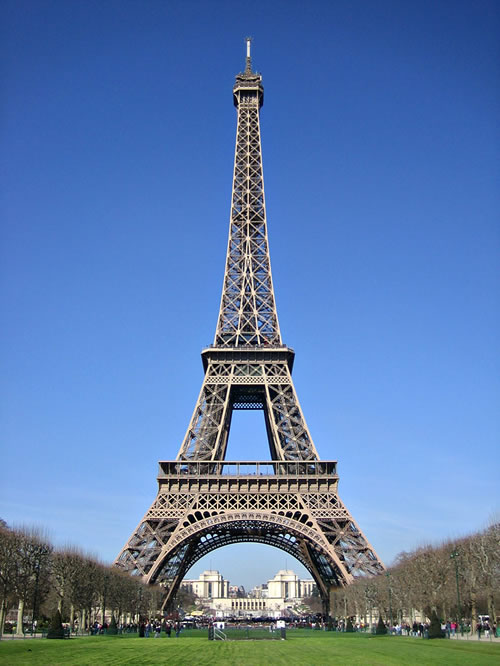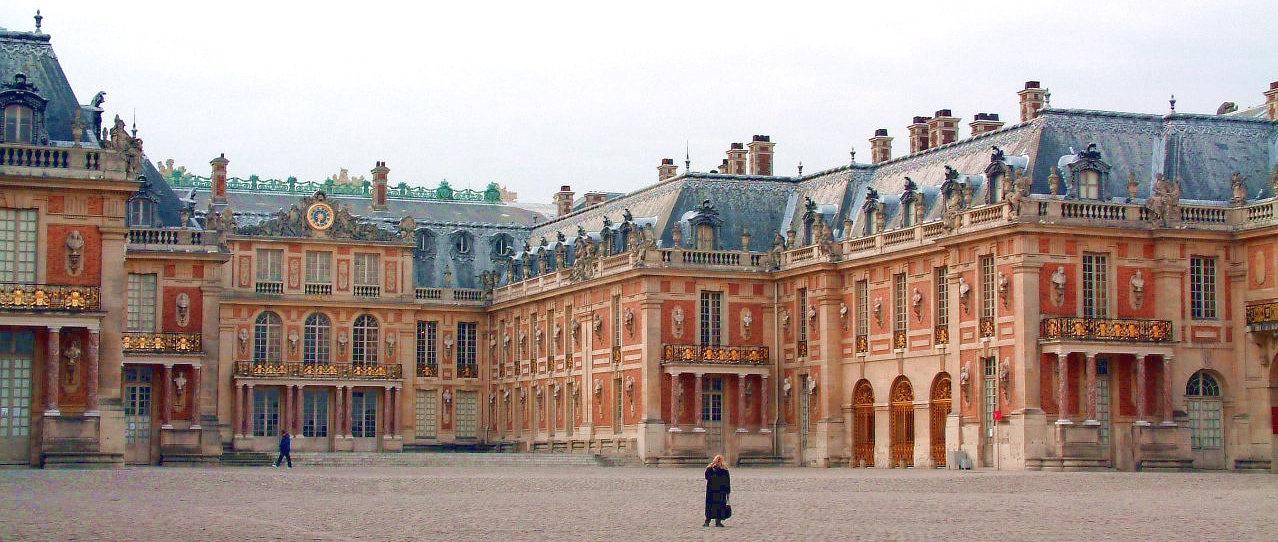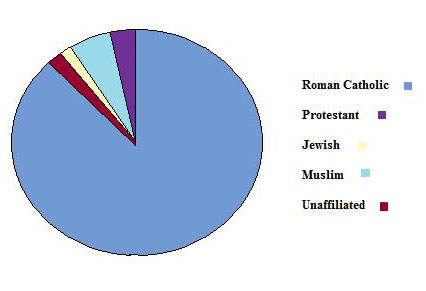GOVERNMENT
 |
| Logo of French Republic |
The French Republic is a unitary semi-presidential republic with strong democratic traditions. The constitution of the Fifth Republic was approved by referendum on 28 September 1958. It greatly strengthened the authority of the executive in relation to parliament. The executive branch itself has two leaders: the President of the Republic, currently Nicolas Sarkozy, who is head of state and is elected directly by universal adult suffrage for a 5-year term (formerly 7 years), and the Government, led by the president-appointed Prime Minister, currently François Fillon.
.jpg) |
Nicholas Sarkozy has been the President of French since 2007 |
The French parliament is a bicameral legislature comprising a National Assembly (Assemblée Nationale) and a Senate. The National Assembly deputies represent local constituencies and are directly elected for 5-year terms. The Assembly has the power to dismiss the cabinet, and thus the majority in the Assembly determines the choice of government. Senators are chosen by an electoral college for 6-year terms (originally 9-year terms), and one half of the seats are submitted to election every 3 years starting in September 2008.
The Senate's legislative powers are limited; in the event of disagreement between the two chambers, the National Assembly has the final say. The government has a strong influence in shaping the agenda of Parliament.
French politics are characterised by two politically opposed groupings: one left-wing, centred around the French Socialist Party, and the other right-wing, centred previously around the Rassemblement pour la République (RPR) and now its successor the Union for a Popular Movement (UMP). The executive branch is currently composed mostly of the UMP.
 |
| The basic principles that the French Republic must respect are found in the 1789 Declaration of the Rights of Man and of the Citizen |
France uses a civil legal system; that is, law arises primarily from written statutes; judges are not to make law, but merely to interpret it (though the amount of judicial interpretation in certain areas makes it equivalent to case law). Basic principles of the rule of law were laid in the Napoleonic Code (which was, in turn, largely based on the royal law codified under Louis XIV). In agreement with the principles of the Declaration of the Rights of Man and of the Citizen law should only prohibit actions detrimental to society. As Guy Canivet, first president of the Court of Cassation, wrote about the management of prisons: Freedom is the rule, and its restriction is the exception; any restriction of Freedom must be provided for by Law and must follow the principles of necessity and proportionality. That is, Law should lay out prohibitions only if they are needed, and if the inconveniences caused by this restriction do not exceed the inconveniences that the prohibition is supposed to remedy.
French law is divided into two principal areas: private law and public law. Private law includes, in particular, civil law and criminal law. Public law includes, in particular, administrative law and constitutional law. However, in practical terms, French law comprises three principal areas of law: civil law, criminal law and administrative law.
France does not recognize religious law, nor does it recognize religious beliefs or morality as a motivation for the enactment of prohibitions. As a consequence, France has long had neither blasphemy laws nor sodomy laws (the latter being abolished in 1791). However, "offenses against public decency" (contraires aux bonnes mœurs) or disturbing public order (trouble à l'ordre public) have been used to repress public expressions of homosexuality or street prostitution.
Criminal laws can only address the future and not the past (criminal ex post facto laws are prohibited) ; and to be applicable, laws must be officially published in the Journal Officiel de la République Française.
France is tolerant of the LGBT community. Since 1999, civil unions for homosexual couples are permitted, although same-sex marriage is illegal in France. Laws sentencing racism, sexism or antisemitism are old and important, for instance, laws prohibiting discriminatory speech in the press are as old as 1881.
In 2010, France passed a law banning face veils in public, including those worn by Muslim women. Amnesty International has condemned the law as a violation of freedom of expression. In September two Muslim women were fined for wearing the niqab (an Islamic face-covering veil), though they appealed the fines.
FOREIGN RELATION
Signing of the Rome Treaty. France is a founding member of the EEC in 1957 and the European Union in 1993
France is a member of the United Nations and serves as one of the permanent members of the UN Security Council with veto rights. It is also a member of the G8, World Trade Organization (WTO), the Secretariat of the Pacific Community (SPC) and the Indian Ocean Commission (COI). It is an associate member of the Association of Caribbean States (ACS) and a leading member of the International Francophone Organisation (OIF) of fifty-one fully or partly French-speaking countries. It hosts the headquarters of the OECD, UNESCO, Interpol, Alliance Base and the International Bureau for Weights and Measures. In 1953, France received a request from the United Nations to pick a coat of arms that would represent it internationally. Thus the French emblem was adopted and is currently used on passports.
Postwar French foreign policy has been largely shaped by membership of the European Union, of which it was a founding member. In the 1960s, France sought to exclude the British from the organization, seeking to build its own standing in continental Europe. Since the 1960s, France has developed close ties with reunified Germany to become the most influential driving force of the EU.
Since 1904, France has maintained an "Entente cordiale" with the United Kingdom, and there has been a strengthening of links between the countries, especially on a military level.
MILITARY
Examples of France's military. Clockwise from top left: Nuclear aircraft carrier Charles de Gaulle; A pair of Rafale fighter aircraft; French Chasseurs Alpins patrolling the valleys of Kapisa province in Afghanistan; a Leclerc tank in Paris for the 14 July Bastille Day Military Parade.
France's armed forces (Armées françaises), comprising the French Army (Armée de Terre), French Navy (Marine Nationale), and the French Air Force (Armée de l'Air), and the auxiliary paramilitary force, the National Gendarmerie (Gendarmerie nationale) is the thirteenth largest in the world.Individually, the Navy employs 42,550 professional sailors and 15,000 part-time reservists and has a displacement 307,000 tons making it the world's sixth biggest navy The Army employs 123,100 regulars and 118,350 part-time reservists making it the fourth largest in NATO. The Air Force is the oldest and first professional air force in the world and employs 57,400 regulars making it also the fourth largest in NATO. While administratively a part of the French armed forces, and therefore under the purview of the Ministry of Defence, the Gendarmerie is operationally attached to the Ministry of the Interior. The gendarmerie is a military police force which serves for the most part as a rural and general purpose police force. It encompasses the counter terrorist units of the Parachute Intervention Squadron of the National Gendarmerie (Escadron Parachutiste d'Intervention de la Gendarmerie Nationale) and the National Gendarmerie Intervention Group (Groupe d'Intervention de la Gendarmerie Nationale). One of the French intelligence units, the Directorate-General for External Security (Direction Générale de la Sécurité Extérieure) reports to the Ministry of Defence. The other, the Central Directorate of Interior Intelligence (Direction Centrale du Renseignement Intérieur), reports directly to the Ministry of the Interior. There has been no national conscription since 1997. The president is the supreme commander of the French Armed Forces. France is a permanent member of the Security Council of the UN, and a recognised nuclear state since 1960. France has signed and ratified the Comprehensive Nuclear-Test-Ban Treaty (CTBT)and acceeded to the Nuclear Non-Proliferation Treaty. France's annual military expenditure in 2010 was US$61.3 billion, or 2.5% of its GDP making it the third biggest military spender in the world after China and the United States of America.
The French deterrence, (formerly known as “Force de Frappe”), relies on complete independence. The current French nuclear force consists of four Triomphant class submarines equipped with submarine-launched ballistic missiles. In addition to the submarine fleet, it is estimated that France has about 60 ASMP medium-range air-to-ground missiles with nuclear warheads, of which ~50 are carried by the Mirage 2000N long-range multirole fighter and arm the Air Force and ~10 can be carried by the French Navy's Super Étendard Modernisé (SEM) attack planes which use the only non-American nuclear powered aircraft carrier in the world, the Charles de Gaulle when at sea. The new Rafale F3 aircraft will gradually replace all Mirage 2000N and SEM in the nuclear strike role with the improved ASMP-A missile with a nuclear warhead.
France has major military industries that have produced the Rafale fighter, the Charles de Gaulle aircraft carrier, the Exocet missile and the Leclerc tank amongst others. Some weaponry, like the E-2 Hawkeye or the E-3 Sentry was bought from the United States. Despite withdrawing from the Eurofighter project, France is actively investing in European joint projects such as the Eurocopter Tiger, multipurpose frigates, the UCAV demonstrator nEUROn and the Airbus A400M. France has the largest aerospace industry in Europe. France is a major arms seller, with most of its arsenal's designs available for the export market with the notable exception of nuclear-powered devices. The military parade held in Paris each 14 July for France's national day is the oldest and largest regular military parade in Europe.






















.jpg)


